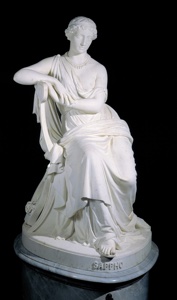William Wetmore Story ( 1819 - 1895)
Sappho
modeled 1862, carved 1867
Marble
Photo courtesy Berry-Hill Galleries, New York.
Early American Art Gallery
Description of Sappho
NARRATOR: The sculpture you are in front of is entitled Sappho and was made of white marble by the artist William Wetmore Story. It was modeled in 1862 and carved in 1867. It is 58 inches tall, 34 inches wide, and 38 inches deep and is displayed upon a waist-high, gray marble pedestal, causing the sculpture to tower several feet above our heads. The sculpture depicts Sappho of Lesbos, a sixth-century-B.C. poet who, according to legend, committed suicide for love.
Sappho is facing towards you, seated in a chair, and the side profile of the chair’s back is on your left. Her flowing, wavy hair is pulled into a bun behind her head. The bun is secured with a ribbon that is nestled across the front crown of her hair to the back where it is tied around the bun. Her face is a perfect oval; her balanced facial features and smooth skin enhanced by the pure milky-white marble from which they are carved. Although her eyes appear empty because they are without visible pupils, her eyelids are slightly closed as though she is looking down, lost in deep thought. Around her neck is a beaded necklace that comes to a slight “V” in the center of her chest. The breast on your right is bared, while the breast on your left is covered by a loose, white garment attached with a clasp at the shoulder. Her garment is cinched at the waist with a thin belt, the fabric draped in folds down her legs to where it pools around the tops of her exposed, sandaled feet. Extra material from her skirt is also draped horizontally from left to right across her lap, and around her back where the material has been gathered to spill over the back of the chair in which she is seated.
The chair is a klismos chair, a type of chair from ancient Greece. A swirling flower and vine pattern along the back of the chair’s frame adds texture to the smooth white marble. Between the back legs of the chair is a sheet of solid marble on which is a circle with a swirling symbol etched upon it. Below this symbol is the word ROMA and the year 1867. Resting against the side of the chair on your left is a wilting rose drooping across an unstrung lyre.
The chair is attached to a 3-inch white marble base. The top of the base has a faint diamond pattern etched onto its surface. Capital letters spelling “Sappho” protrude slightly from the front of the base. Below the white base, the layered gray marble pedestal is triangular with rounded corners. A layered lip extends around its top. Beneath the lip, the pedestal is smooth and even for about two feet until another layered lip extends around its bottom. Beneath the gray marble pedestal is a 6 inch wooden platform, painted light gray to blend in with the gray marble of the pedestal.
[End of Stop]



